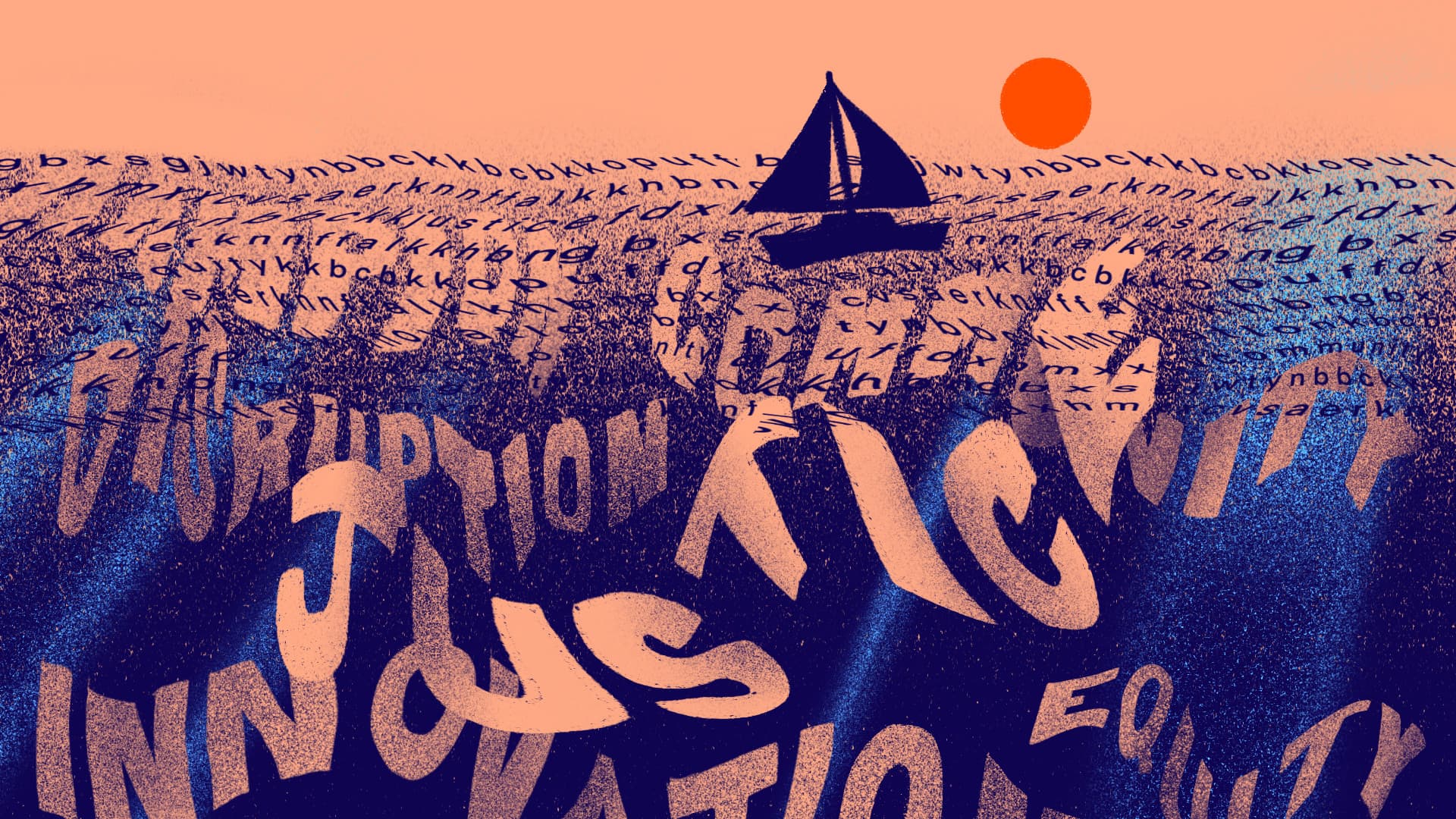Rowing In the Same Direction
To what extent should your nonprofit’s mission line up with your employees’ personal values?
By Deroy Peraza, Partner at Hyperakt
We often hear that people gravitate toward working in the social impact space because they want to work on issues that align with their values. It sounds like a beautiful motivation, but beneath the surface, it’s a lot more complicated than it seems.

Illustration by Merit Myers
Organizations, regardless of how progressive they may or may not be, are populated with all kinds of people. These people have come from different places, have enjoyed different degrees of privilege, have had different experiences of personal safety, of inclusion or discrimination. They have different cultural identities, family histories, political affiliations. They will bring to their work different views of the world, different versions of what’s ethical and what isn’t, different lines in the sand of what they are willing and not willing to give up.
When a collective of people are inspired to work with an organization, and that organization has its own governing values, there’s bound to be some tension, even conflict, among those diverse points of view. And sometimes an activity or event — fresh leadership, a new direction, or the rigorous process of branding or rebranding — bring those tensions to a head. But Maurice Mitchell, in his insightful article, “Building Resilient Organizations,” shares an important reminder:
Personal vs. organizational values
Divergent values among staff are often hard for organizations to square for a few reasons:
The organization’s mission and strategy hasn’t been made clear to the team. Social change work— whether its narrative change, system change, service delivery, advocacy, coalition work, philanthropic investing, etc—often requires working with partners across the political and power spectrums. For any collaboration to happen, all partners or audiences need to feel heard. Everyone needs to be aware of triggers that might block other partners. These are often in conflict with each other.
The organization’s leadership hasn’t made it clear to their teams that there is a difference between the organization’s strategy and individual values and political positions. Social change (and the systemic change it requires) is a chess game. It requires working gradually and ceaselessly to balance the values of the change agents with the motivations of the audiences they’re trying to convince that change needs to happen. This requires compromise and letting go of ideological purity. It requires embracing imperfect solutions and a “we can all win” mentality. The art of doing this work well is sacrificing as little as possible.
What’s more, people who approach the work from a place of privilege often look at systemic challenges from an academic or data-driven perspective. They often don’t come from or live in historically excluded communities (largely Black and Brown) who have experienced poverty, discrimination, violence, and lack of opportunity. The anger, distrust, and fear that these communities feel is justified. Why would we expect for people who have had such different experiences to see the world in the same way? In spite of these differences, it’s critical that they find ways to work together, build trust, empathy, and understanding to tackle challenges together. This means everyone needs to stretch out of their comfort zones to meet the other–especially those of us with privilege
There simply hasn’t been time and space for people on the team with different perspectives to engage with their work in conversation and to hear each other’s perspectives. Communication is built on conversation. On understanding where we all come from. On listening. On finding common ground. On learning about differences. It takes time and it requires safe spaces where people can share.
A personal leadership reflection
I’ll share a personal example of how I’ve experienced this from the perspective of leading a team. In the wake of social protests and racial awakening in the summer of 2020, our agency experienced some internal struggles over what our position was—what does being a social impact design studio mean?– and what our response should be.
Hyperakt is a design studio that works alongside nonprofits and social change organizations to ensure their brands are furthering their potential for impact. We are not a nonprofit or social change actor ourselves—we are experts in communication who support those doing the work.
Up to that point, we used a lot of language in our marketing that made the agency appear to be an activist organization. We even called people on the team Hyperaktivists. But that didn’t really reflect our work. We’re not activists. We don’t have the lived experience as individuals to be true activists. Our leadership team includes several immigrants, yes, but we have been lucky to have had ample opportunity in this country. We come from families with very diverse political points of view. And so we are led to take a very pragmatic approach to our work, finding ways to compromise, to give and take, to bring on people with different points of view.
In 2020, we had a couple of employees leave because they expected that Hyperakt would take more of an activist position. The difficult conversations that arose prompted us to intentionally focus our own brand positioning more on the fact that we are not ourselves the changemakers; we are here to help the changemakers figure out how to do the work, to lend our expertise and experience to their cause. Ensuring our staff is clear on where we stand, and on what to expect from us has been critical to bringing our team together and ensuring team member retention.
Brand strategy clarifies organizational strategy
When we work with nonprofits in the social justice space to define and express their brand strategy, our close work with internal teams often surfaces a divergence between individual values and organizational ones. Ideological struggles are endemic in most nonprofits right now.
Brand strategy provides clarity; it’s the cohesive expression of the organization’s mission, purpose, and values. Nonprofit leaders tend to assume that their teams are already aligned on an organizational strategy and they just need a new logo and website.
But often, they’ve never taken the time to gather their team, to sit together and talk about the work and what it means and how it happens. People need to understand, share input, and decide if they want to be a part of it — that happens during brand strategy work.
When organizations fail to clearly define what they stand for, the resulting vacuum gets filled with the competing values of the individuals that make up their team. It also creates opportunities for those on the outside trying to purposely cause damage.
Nonprofit leaders need to go into the branding process with eyes open and to be OK with the possibility that people may not embrace what you’re doing and focusing on. While that seems scary, there are three practicalities to keep in mind.
First, it’s impossible for an organization to perfectly align with the moral and ethical compass of all of its people. Its responsibility to current and potential employees with it is to be clear about what its strategy and approach is, what audiences it’s trying to win over and work with, and what that might mean in terms of making tradeoffs.
Second, organizational strategy is about finding the most viable and impactful path to achieving a goal. That usually means working with people who think very differently, who have different agendas and motivations, and who have different experiences.
Last, without doing the work of wrestling with these tensions, laying all the cards on the table, and aligning as a team, it’ll be very difficult to communicate clearly to external audiences and accomplish goals.
Facilitating any kind of change is messy. It requires that we set aside rigid ideology and engage with people whose views or interests may conflict with ours. To persuade, we have to meet people where they are and use their own language, even if it grates on our ears. Organizations have to be fully transparent with their internal and external audiences about their goals and methods. Giving everyone this knowledge will empower them to decide whether they’re willing to go along for the ride.
If this challenge feels relevant to your nonprofit, let’s get in touch.


